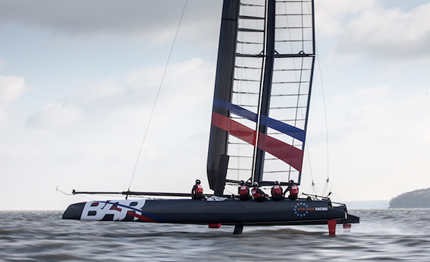PRESS
America's Cup, BAR: the fitter they are the faster they fly

redazione
The America's Cup is the oldest trophy in world sport – dating back to before the Ryder Cup, FIFA's World Cup and even the modern Olympics. It's also the only major sporting event that Britain has never won. Those failures – and there have been twenty of them – dot back through a time when the Cup was contested in majestic but distant yachts. Those yachts glided, apparently serenely across white-capped oceans. It was a limited view, accessible only to those who could get afloat, and not particularly accurate.
Technology, in the way of onboard cameras, eventually brought the audience onboard and revealed the truth. While it was serene from a distance – and sometimes it was even serene close-up – there were moments of frenzy onboard when the whole crew was moving. Huge men with lung capacities the size of Olympic rowers (several of them were) pounded at handles until their eyes bulged. And then they sat down and waited for the next moment of action. It could be 20 minutes away.
Those days are gone. There's nothing serene about the new America's Cup boats, not close-up, not even from a distance. The key to speed in the new America's Cup is achieving continuous stable 'flight' through ever changing conditions of wind and water. This requires constant adjustment of both hydrofoils and aerofoils, and that requires an equally constant supply of power. The majority of that power is supplied through a hydraulic system, similar to those used to control the flight surfaces of aircraft and F1 race cars.
In February 2010, the 33rd America's Cup was won by a 90 foot multihull. It used a 100hp car engine to provide the necessary power to the hydraulics. The 35th America's Cup will be raced in 48 foot foiling multihulls, and the rules state that there will be no engine. Instead, there will be just six crew. At all times, one of them will be required to adjust the hydrofoils, another to control the aerofoils. The other four must wind handles to feed the hydraulics with juice. They must keep it up for the entire race and, collectively, these six must weigh no more than 525kgs.
Before Ben Ainslie Racing's designers and engineers could sketch a single line of the boat that they hope will win the America's Cup, they needed to ask the sailing team one question; how much power could they deliver for the duration of the 30-40 minute races, raced twice a day, day after day for up to 20 days? The answer to that question is fundamental to the design of the boat. And the man in charge of delivering it is the team's strength and conditioning coach, Ben Williams.
"Previously America's Cup sailors were power/sprint athletes, like a 200m runner or a 100m runner," said Williams. "Now they are more akin to a 10km runner, or a rower, or a time trial cyclist because they are producing constant wattage without going into the red for 40 minutes. So they have become endurance athletes. We did a lot of development work and then went and talked to the design team about how much power we thought we could give them with the four guys in June 2017 (the date of the next America's Cup). They will use that number; so the amount of power the sailors can deliver is central to the design of the boat." Now all that Williams has to worry about is how to deliver on the promise, with a team of sailors talented enough at their craft, strong enough mentally and cohesive enough as a competitive unit to win the America's Cup. "I put all the aspects of that together and came up with a performance map," he explained.
"The more often I can deliver those guys to the boat uninjured with a maximum amount of energy and power ability, fully hydrated, the better they will become tactically, emotionally, physically and mentally. So we have created an environment where the most important thing is prehabilitation (training that aims to prevent injuries); mobility, flexibility, and the ability to get into different positions under load and not get injured. That forms the foundation of our training. Then we have the crew weight restrictions to consider, and we have to be able to create that defined amount of power."
"We've got this jigsaw, we've got all these great sailors and what we have got to do is find the right six that fit onto that boat so that there are no pieces missing. All while producing the target amount of power over long periods of time, being quick and agile, and making complex decisions under stress." Williams smiled, and added the line that I suspect will haunt the sailing team for the next two years. "It's not going to be easy, it's definitely not going to be fun, but it is definitely achievable."
by Mark Chisnell
29/04/2015 23:10:00 © riproduzione riservata
Tweet
CORRELATI
DELLA SETTIMANA
San Foca: IV regata "Più Vela per Tutti"
Un mare affollato quello di ieri al largo di San Foca, grazie ad una bella giornata di sole e di vento ‘giusto’, anche per la flotta di ‘Più Vela Per Tutti’, che ha disputato la sua quarta regata del campionato invernale
50° Invernale del Tigullio: sorridono Spirit of Nerina, Sease e Ariarace
Spirit of Nerina (ORC A-B), Sease (ORC C) e Ariarace (Rating FIV). Sono questi gli equipaggi che festeggiano al termine della prima manche del 50° Campionato Invernale del Tigullio
Trofeo Jules Verne: partito anche Thomas Coville
Sodebo Ultim 3, il maxi-trimarano francese guidato da Thomas Coville, è salpato il 15 dicembre 2025 per un nuovo tentativo di record sul Trofeo Jules Verne, il giro del mondo senza scalo né assistenza
Invernale Napoli: vincone Raffica, Eurosia Pompa Pa’ e Sly Fox Cube
L’equipaggio di Orofino vince il Trofeo Gaetano Martinelli (ORC), quello di Neri e Cassese il Trofeo Oreste Albanesi (Sport Boat), mentre il team di Fotticchia conquista il Trofeo Paola Martinelli (Gran Crociera)
Napoli: oltre 100 barche in acqua per sostenere Telethon
Grande successo per il Trofeo Fondazione Telethon, la regata destinata a raccogliere fondi a favore della ricerca sulle malattie genetiche rare
Thailandia: una Regina in regata
Sua Maestà la Regina Suthida di Thailandia scenderà in acqua insieme al Team Thailandia per le regate della Star Sailors League
Tre Golfi Sailing Week 2026: oltre cento equipaggi da sedici Paesi per un’edizione memorabile
Più di 100 imbarcazioni provenienti da 16 Paesi hanno confermato la propria partecipazione, a testimonianza di quanto questo appuntamento sia ormai tra i più prestigiosi e attesi del calendario velico internazionale
Star Sailors League: vittoria thailandese con la Regina Suthida in equipaggio
La vittoria thailandese ha avuto anche un significato storico: a bordo dell’SSL47 numero 6 c’era infatti Sua Maestà la Regina Suthida, in ruolo attivo come tattica e timoniera, alla guida del team di casa nelle acque di Pattaya
Mondiale Youth, Italia sul podio: tre medaglie e Nations Trophy a Vilamoura
La squadra italiana chiude la rassegna iridata con tre medaglie e conquista per il terzo anno consecutivo il Nations Trophy, confermandosi ai vertici della vela giovanile internazionale
